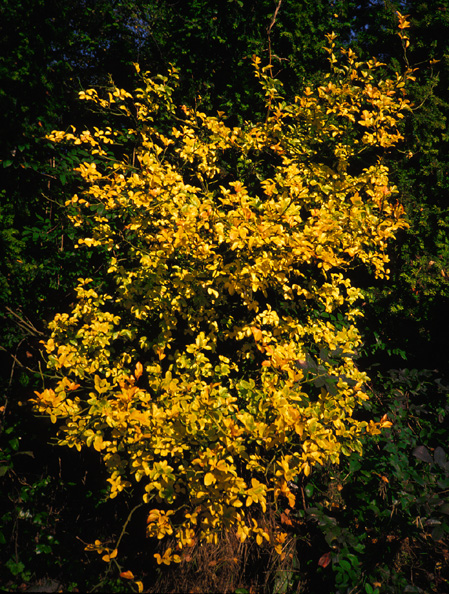
|
| Hardy Citrus; Poncirus trifoliata (L.) Raf. |
Rue Family; RUTACEÆ
|
| Hardy Citrus is a fascinating shrub, worthy of wider use in the Seattle area. The Hardy Citrus is also called Hardy Orange, Spiny Orange, Bitter Orange or Trifoliate Orange. It is a spiny deciduous species from China and Korea. It is scientifically designated Poncirus instead of Citrus because it is not evergreen (except while a seedling), has trifoliate leaves, fuzzy fruit, and other abstruse technical differences. On a practical note, it is cold-hardy, unlike Citrus in general. We can easily grow Hardy Orange bushes in the Seattle area. |
| If you plant this striking and rare shrub in a visible place near your house, passersby and visitors will gape and ask "what's that?" In winters its stout green twigs, densely twisted and fiercely armed with nail-like thorns, present a rigid, commanding sight. |
| In May or June pretty, white flowers, 1-2 inches wide, erupt, and its trifoliate leaves come on, growing into a rich glossy backdrop for the dull, fuzzy, little green fruits that form. By late summer or autumn the 1-2 inch wide fruit turns to a sort of half-hearted orange color and is amazingly fragrant and alluring. |
| Its fuzzy skin, thick, almost resinous pulp and intense flavor make it too much (or too little) for most tastes. However, some cooks have created delicious marmalade with the processed fruit. People with sensitive skin, on the other hand, have had bad dermatitic reactions from handling the raw fruit. So nobody really tries to grow this species as a fruit-bearer. Its role is as an ornamental or a rootstock. |
| In China, its uses include medicinal applications and cooking the young leaves as a vegetable. The spiny branches can be cut and used as curious decorations. As a barrier hedge, this stiff, spiny shrub has few peers. |
| Poncirus has been grown most often by Citrus fanciers who wish to use its cold-hardiness to extend the range of their fruiting Citrus crops. They do this either by one or two ways. The first is by using hybrids of it and other Citrus, such as the Sweet Orange (Citrus sinensis). The 'Troyer' Citrange is one of over a dozen such hybrids that exist. Or growers instill regular Citrus trees with some cold-hardiness by grafting them onto the Poncirus rootstock. If we grew some of these hardy rootstocks for a few years in the Seattle area, then grafted Kumquats, Calamondins, Meyer Lemons or Sour Oranges onto them, we might be able to harvest fruit outdoors here! It would be worth a try. |
| A word about cultural requirements: the plant will survive on many soils and in various degrees of sunlight. But the ideal site may be rich, moist, yet well-drained sandy loam, with ample sunlight and heat. A light sandy soil, poor in nutrients and dry in summer is wretched. Heavy fertilization is an excellent practice. |
| In the South, where in some localities the Hardy Orange now grows wild, the largest specimens are, after decades of growth, up to 35 feet tall, 25 feet wide, with trunks up to 16 inches in diameter. In the Pacific Northwest there are very few, and specimens over 12 feet tall are extremely rare (One in Portland, Oregon, at the Bishop's Close Elk Rock garden is nearly 15 feet tall, over 19 feet wide and its trunk 8 inches thick in 2003). The shrub/tree common here that is most like Poncirus in size and form may be the Star Magnolia (Magnolia stellata). |
| An even smaller-growing selection of the Poncirus is called "Flying Dragon" or "Hiryo" --it was introduced to the U.S. from Japan in 1915, and has tortuously twisted branches. It is thus valuable either as an odd little conversation piece or as a real dwarfing Citrus rootstock. |
You can view a Hardy Citrus at the Washington Park Arboretum; it grows north of the path that leads from the Azalea Way parking lot (east of the covered lookout above the pond), and has dark yews as a background (PHOTO ABOVE). Seedlings may be purchased from various nurseries. Large sized specimens are extremely hard to locate for purchase.
|
(Originally published in the May 1989 Seattle Tilth newsletter, along with an illustration by Annie Figliola.)
Back |
|
|

